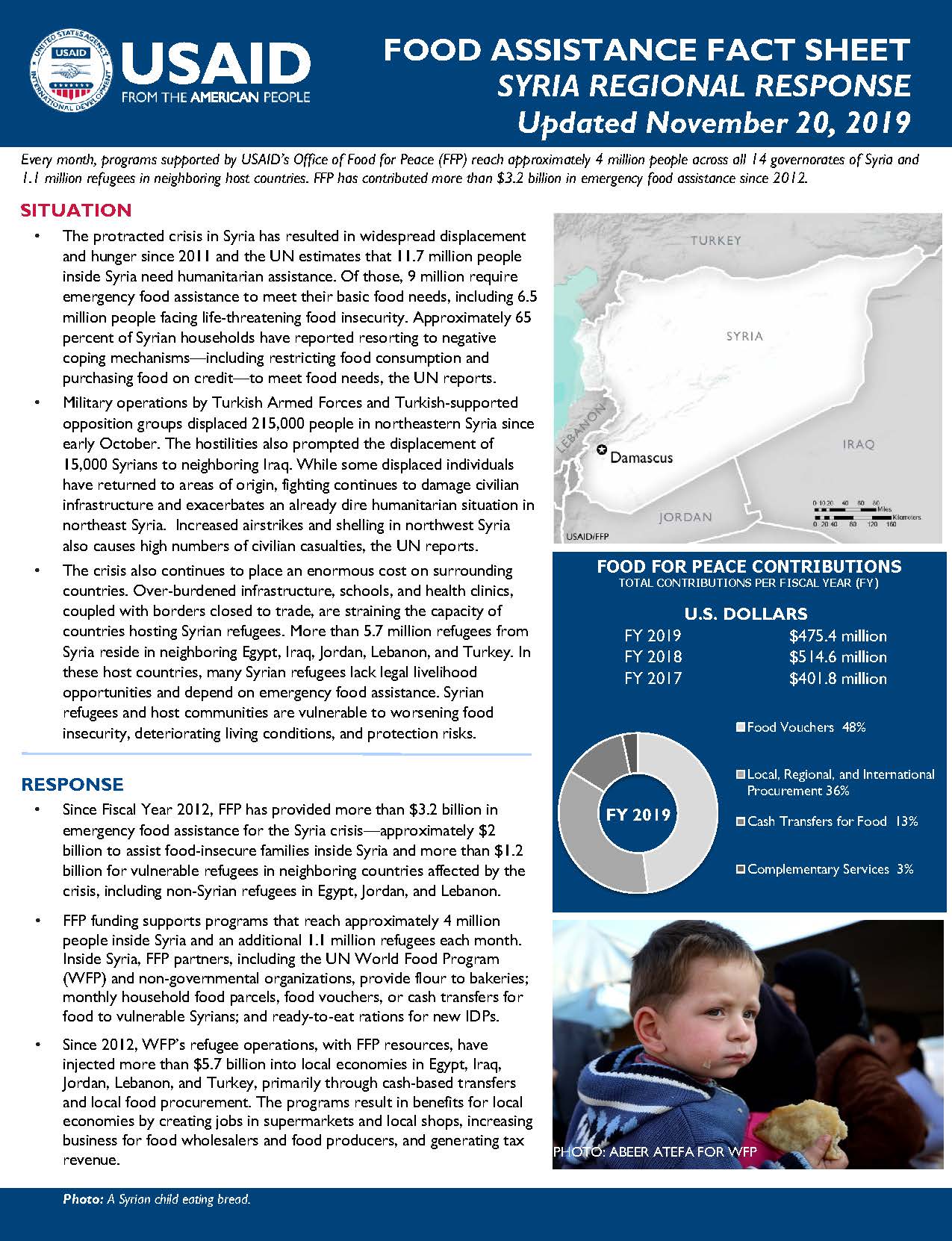Home » What We Do » Agriculture and Food Security » Food Assistance » Where We Work » Food Assistance Fact Sheet - Syria
- What We Do
- Agriculture and Food Security
- Democracy, Human Rights and Governance
- Economic Growth and Trade
- Education
- Environment and Global Climate Change
- Gender Equality and Women's Empowerment
- Global Health
- Humanitarian Assistance
- Transformation at USAID
- Water and Sanitation
- Working in Crises and Conflict
- U.S. Global Development Lab
Speeches Shim

November 20, 2019
Every month, programs supported by USAID’s Office of Food for Peace (FFP) reach approximately 4 million people across all 14 governorates of Syria and 1.1 million refugees in neighboring host countries. FFP has contributed more than $3.2 billion in emergency food assistance since 2012.
Situation
- The protracted crisis in Syria has resulted in widespread displacement and hunger since 2011 and the UN estimates that 11.7 million people inside Syria need humanitarian assistance. Of those, 9 million require emergency food assistance to meet their basic food needs, including 6.5 million people facing life-threatening food insecurity. Approximately 65 percent of Syrian households have reported resorting to negative coping mechanisms—including restricting food consumption and purchasing food on credit—to meet food needs, the UN reports.
- Military operations by Turkish Armed Forces and Turkish-supported opposition groups displaced 215,000 people in northeastern Syria since early October. The hostilities also prompted the displacement of 15,000 Syrians to neighboring Iraq. While some displaced individuals have returned to areas of origin, fighting continues to damage civilian infrastructure and exacerbates an already dire humanitarian situation in northeast Syria. Increased airstrikes and shelling in northwest Syria also causes high numbers of civilian casualties, the UN reports.
- The crisis also continues to place an enormous cost on surrounding countries. Over-burdened infrastructure, schools, and health clinics, coupled with borders closed to trade, are straining the capacity of countries hosting Syrian refugees. More than 5.7 million refugees from Syria reside in neighboring Egypt, Iraq, Jordan, Lebanon, and Turkey. In these host countries, many Syrian refugees lack legal livelihood opportunities and depend on emergency food assistance. Syrian refugees and host communities are vulnerable to worsening food insecurity, deteriorating living conditions, and protection risks.
Response
Food Assistance Fact Sheet - Syria ![]() (pdf - 203k)
(pdf - 203k)
- Since Fiscal Year 2012, FFP has provided more than $3.2 billion in emergency food assistance for the Syria crisis—approximately $2 billion to assist food-insecure families inside Syria and more than $1.2 billion for vulnerable refugees in neighboring countries affected by the crisis, including non-Syrian refugees in Egypt, Jordan, and Lebanon.
- FFP funding supports programs that reach approximately 4 million people inside Syria and an additional 1.1 million refugees each month. Inside Syria, FFP partners, including the UN World Food Program (WFP) and non-governmental organizations, provide flour to bakeries; monthly household food parcels, food vouchers, or cash transfers for food to vulnerable Syrians; and ready-to-eat rations for new IDPs.
- Since 2012, WFP’s refugee operations, with FFP resources, have injected more than $5.7 billion into local economies in Egypt, Iraq, Jordan, Lebanon, and Turkey, primarily through cash-based transfers and local food procurement. The programs result in benefits for local economies by creating jobs in supermarkets and local shops, increasing business for food wholesalers and food producers, and generating tax revenue.
Food for Peace Contributions
Total Contributions:
| Fiscal Year | U.S. Dollars |
|---|---|
| Fiscal Year 2019 | $475.4 million |
| Fiscal Year 2018 | $514.6 million |
| Fiscal Year 2017 | $401.8 million |
Country Specific Guidance
Related Resources
- Syria Complex Emergency
- Syrian Mom Grows Vegetable Garden to Feed Her Children
- Syrian refugees in Turkey: Happy to be alive


Comment
Make a general inquiry or suggest an improvement.